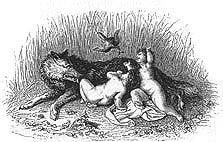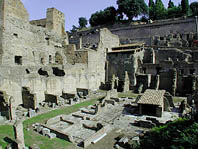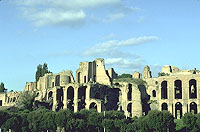Roman Forum Area
Palatine Hill
(Palatino). All the Palaces in the world are named after this hill - because here the Emperors built their stupendous homes. Never before or since the Roman Empire did the world see such, yes, PALATIAL houses.
Starting with Octavian Augustus most of the Emperors lived and ruled from atop this hill that Romans considered holy as it was the original site Romulus and Remus settled. The massive ruins can only hint at the magnificence there used to be.
| Palatine History
|
Walk up the "Clivus Palatinus" from Titus' Arch in the dusty Roman Forum and you find yourself on glorious tree-shaded lawns. Here it is even harder than in the Forum to imagine the stupendous buildings of this cradle of Rome's history - all vanished.
Start your walk by turning right at the top of the Clivus; follow the signs to Orti Farnesiani:
Farnese Gardens
(Orti Farnesini). Don't miss the box-hedge maze or the views over the Roman Forum.
When Renaissance architect Vignola planned what was the first botanical garden in the world, it started at the level of the Forum (which was then half hidden by landslides from this hill) and ascended in terraces like the Hanging Gardens of Babylon.
Very little of the Domus Tiberiana (Tiberius' House) below the gardens has been excavated. Caligula, whose palace was at the edge closest to the Forum, had an aerial walk built over to the Capitol to save time when going to official functions at the Temple of Jupiter!
From the side of the gardens furthest from the Forum, walk down to the ruins of Cybele’s temple.
Temple of Cybele
(Tempio di Cibele, 204-191BC). This Goddess, also known as "Magna Mater" (big mamma) was brought from Phrygia to Rome in the form of a Black Stone when things looked bleak during the Second Punic War against Carthage. Since the tide of battle immediately turned, the appreciative Romans built a Temple here for Cybele's statue - which is about all you can see today; it has been placed nearby under an arch of Tiberius' Palace.
Two Antique Cisterns
(Due antiche Cisterne, 6C BC). The best preserved is round, with a beehive vault. Romans from the very beginning showed a healthy concern for having water available. 1000 years would pass before the invading Goths cut off their water. At the rear of Cybele's temple are excavations of:
Romulus' Hut Village
 (Villaggio di Romolo) Although many were skeptical, mythology held this to be the site of the founding of Rome where the twins Romulus and Remus had been nursed by the she-wolf in the nearby Lupercal or wolf's cave. They had a contest to decide who would be leader, but, when Romulus plowed the area he proposed for the city, Remus mocked him by jumping over the furrow -- so Romulus killed his brother in the first of what would be a long history of sibling rivalry and dynastic murder in the Eternal City.
(Villaggio di Romolo) Although many were skeptical, mythology held this to be the site of the founding of Rome where the twins Romulus and Remus had been nursed by the she-wolf in the nearby Lupercal or wolf's cave. They had a contest to decide who would be leader, but, when Romulus plowed the area he proposed for the city, Remus mocked him by jumping over the furrow -- so Romulus killed his brother in the first of what would be a long history of sibling rivalry and dynastic murder in the Eternal City.
In 1907 archaeologists were surprised to find the postholes for three huts that they dated to approximately the 8C BC, partially vindicating the myth.
Walking toward the center of the Palatine, you reach:
Livia's House
(Casa di Livia) So-called because of lead pipes you can see here engraved IULIAE AV (Julia Augusta) which was interpreted as meaning "Emperor Augustus' Wife." Since Augustus probably moved into the house of his wife Livia's first husband, this seemed to make sense, but current experts think this was actually where Augustus himself lived.
Delicately frescoed walls have been maintained here and give a good idea of the sophisticated taste that epitomized The Golden Age of Augustus. (The same delicately bosky dining room frescoes were in her Villa Livia at Prima Porta on the outskirts of Rome, and are now on view in the Palazzo Massimo Museum. See: Museums)
Don't miss the griffins and false marble in these paintings, which date to the time of the finest houses in Pompeii. Adjoining are the sparse remains of Temple of Apollo and Augustus' House.
Temple of Apollo and Augustus' House
(Tempio di Apollo e Casa di Augusto). Emperor Augustus built this private temple as an act of thanksgiving to the god who helped him defeat his brother-in-law and last rival, Marcus Antonius (Marc Antony, who scandalized the family by running off with Cleopatra).
It was also a smart career move to show the Romans that he was "favorite of the gods." Rome's great biographer Suetonius (2C AD) wrote "Augustus found the city of Rome brick, and left it marble...lived in an unpretentious house...slept in the same bedroom for over 40 years".
Extending from the corner of Livia's House closest to the Forum is:
Criptoporticus
(Criptoportico). A Greek-sounding name for a network of passages under a large Roman house, permitting slaves to scurry unseen between palaces. This one runs 400 feet/130 meters along the side of the Farnese Gardens.
You can see the openings for light and air and copies of the finely stuccoed vaults.
Domus Flavia
(Casa di Flavia, 81-92 AD. Architecture Rabirius) These ruins are part of the "golden ghetto" that Emperors Vespasian, Titus and especially Domitian built for themselves. Flavia is not a woman, but the name of their family dynasty.
This part, being closest to the Forum, was for official business and ceremonies. The six staterooms are:
Basilica Where the Emperor met with his Councilors and meted out justice from a niche perched above the others.
Aula Regia In this Throne Room, Augustus impressed his visitors with its huge size, almost as large as the Pantheon, and its gigantic statuary.
Lararium Nominally the Emperor's private chapel, graffiti show it was used more by his bodyguards.
Peristyle Central courtyard with octagonal fountain. The hated Domitian's stress level was reduced by daily walks in this patio whose walls of polished black marble served as mirrors so that he could see if someone was behind him. This did not protect him from being murdered - in his bedroom and reportedly on orders of his wife Domitia.
Triclinium This huge covered Banquet Hall has a gorgeous marble floor under which hot air circulated to heat the lucky diners in Winter. (Early central heating!)
Nymphaeum For Summer dining, the lovely oval fountain would give it’s cooling effect and cascade onto the dazzling floor taken from Nero's house.
Domus Augustana
(Casa di Augusto) The official residence of the Emperors for 300 years was on two or three floors, but all you see today are two Peristyles (courtyards) and immense ruined walls. There may have been a thousand rooms.
The Peristyle to the North had a pool with a small temple which was reached by a soaring bridge.
Look down at the Southern Peristyle on the lower floor, with symmetrical tracery in the central fountain, surrounded by sumptuous apartments that were complete with toilet facilities.
The imperial family had direct access to its private box for watching races in the Circus Maximus far below. (From which you get a good view of the engineering feat these palaces represent.)
Stadium
(Stadio). Look down at Domitian's private Hippodrome, about the size of a football field, where imperial guests could view the races from all sides.
The oval ruin down at the far end, was a riding school built by the gentle Ostrogothic King Theodoric who ruled between here and his main seat in Ravenna from 493 AD until Byzantium became all-powerful in 526.
Domus Severiana
(Casa di Septimius Severus, 193-211 AD). As virtually the whole of the Palatine Hill had been covered with Imperial Palaces, this African-born Emperor built his beyond Domitian's Palace on a terrace supported by enormous brick arches.
Adjoining the "Stadium" he added gorgeous "Baths" connected to the Aqua Claudia springs by the aqueduct you can see at the West End of the Palatine.
At the very end, in sight of both the Circus Maximus and the Colosseum, but torn down in the 16C, was his "Septizonium", a multi-storied fountain to dazzle all those arriving in Rome from the South.
 753 BC. Rome was founded by a tribe of wandering shepherds, whose traditional leader Romulus, having dispatched his brother Remus after a plowing contest around this hill, decided they should build a hamlet of thatched huts here not far from the Tiber.
753 BC. Rome was founded by a tribe of wandering shepherds, whose traditional leader Romulus, having dispatched his brother Remus after a plowing contest around this hill, decided they should build a hamlet of thatched huts here not far from the Tiber.